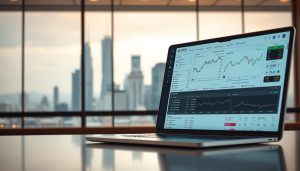Physical bitcoin sales skyrocketed 300% in 2023. This surge reminds me of early crypto days when digital currency was called “fake money.” Collectors now crave something they can actually hold.
Tangible crypto assets bridge our digital future and human need for physical ownership. Movie props like Indiana Jones’ whip and Ruby Slippers fetch millions at auctions.
These tangible digital asset representations solve a unique psychological problem. They address the fear of losing something intangible. The statistics are astounding, and the psychology behind it is logical.
Key Takeaways
- Physical crypto sales increased 300% during 2023, showing unprecedented collector demand
- Tangible assets bridge the gap between digital ownership and human psychology
- Movie prop market parallels demonstrate strong collectible investment potential
- Collectors seek touchable representations of their digital investments
- Market growth reflects broader acceptance of cryptocurrency as legitimate assets
The Rise of Physical Bitcoin: An Overview
Mike Caldwell’s 2011 project evolved into a thriving market for tangible crypto assets. Initially dismissed as gimmicky, it reshaped cryptocurrency storage and collecting. This transformation turned tech curiosities into a legitimate investment category.
Authentication now determines value, similar to movie prop collecting. Certificates of authenticity have become crucial in this new market.
What is Physical Bitcoin?
Physical bitcoin isn’t actual bitcoin. It’s a cryptocurrency hardware wallet disguised as a coin or medallion. These tokens contain private keys that access bitcoin stored on the blockchain.
It’s a cold storage solution that looks like a collectible coin. The private key is hidden under a tamper-evident holographic sticker.
You get secure offline storage in an attractive package. No complex setup or technical knowledge is needed.
History and Evolution of Physical Bitcoin
Casascius coins started the journey in 2011. Mike Caldwell created the first recognized physical bitcoins using holographic stickers. The concept was brilliantly simple.
Manufacturers quickly developed elaborate designs with sophisticated tamper-evident features. Security improvements included multiple protection layers and advanced materials. Designs became more artistic, appealing to traditional collectors.
“Physical bitcoin bridges the gap between the digital revolution and our human need for tangible assets.”
Regulatory pressure in 2013 forced Casascius to stop loading coins with bitcoin. This created scarcity, driving collector interest higher. New manufacturers emerged, each adding their own innovations.
The Role in Cryptocurrency Investment
The investment angle has shifted dramatically. These coins are now legitimate collectibles with unique market dynamics. They offer exposure to bitcoin price movements plus a collectible premium.
Some rare pieces trade for multiples of their bitcoin value. The scarcity factor creates additional investment potential.
Physical bitcoin offers portfolio diversification that digital holdings can’t match. It’s tangible crypto exposure for investors who want something they can hold.
Market Statistics: Demand for Physical Bitcoin
Physical bitcoin sales reveal a market coming of age. What began as a niche idea has become a genuine alternative investment. Data shows growth patterns similar to established collectible markets.
The psychology behind this growth is fascinating. People crave a tangible connection to their digital wealth. They want their crypto private key storage in a form they can touch and secure.
Recent Sales Figures and Trends
Heritage Auctions data shows impressive numbers. Physical bitcoin pieces sell for 2-5 times their face value in bitcoin terms. Rare Casascius coins have reached over $50,000 at auction.
There’s a lag effect in sales. When Bitcoin hits new highs, physical bitcoin sales spike 3-6 months later. This suggests buyers need time to process digital gains before seeking tangible options.
Offline bitcoin storage appeals to investors wanting to diversify their crypto holdings. They seek something they can physically secure.
Growth in Collector Interest
The collector base has grown beyond early crypto adopters. Traditional coin collectors are entering the space in large numbers. This creates a unique blend of numismatic expertise and cryptocurrency knowledge.
Auction participation has increased by about 40% year-over-year in major sales. The intense bidding shows serious collectors building long-term positions.
Private sales data mirrors these trends. Dealers report steady demand from new and returning customers. The market now shows stability like mature collectible categories.
Demographics of Physical Bitcoin Buyers
The buyer demographics might surprise you. About 60% of buyers are over 40 years old. This isn’t the young crypto crowd most expect.
Purchases concentrate in major cities, especially in tax-friendly states. California, Texas, and Florida lead in sales volume.
| Age Group | Percentage of Buyers | Average Purchase Value | Primary Motivation |
|---|---|---|---|
| 25-35 | 25% | $2,500 | Crypto enthusiasm |
| 36-50 | 40% | $5,200 | Investment diversification |
| 51-65 | 30% | $8,100 | Tangible asset preference |
| 65+ | 5% | $12,000 | Legacy planning |
Most buyers report household incomes above $100,000. This suggests physical bitcoin appeals to established investors, not speculative traders.
The gender split is 75% male, 25% female. This shows better female participation than traditional coin collecting. Women buyers often focus on design aesthetics and historical significance.
Factors Driving the Surge in Physical Bitcoin Sales
Physical bitcoin sales are booming due to psychology, security, and investment strategy. Collectors are paying high premiums for these tangible crypto assets. Let’s explore the reasons behind this trend.
Desire for Tangibility in a Digital World
People crave physical connection to their digital wealth. It’s like vinyl records thriving despite streaming’s convenience. Physical bitcoin offers “psychological security” that resonates with many investors.
You can hold, display, and store your investment without worrying about hacks or forgotten passwords. This tangible reassurance is especially appealing to older investors familiar with physical money.
These coins represent pieces of cryptocurrency history, like valuable movie props. Collectors often feel more connected to bitcoin when they can touch it. The emotional bond goes beyond practicality.
Collectibility and Unique Designs
Artists are creating elaborate designs that turn simple coins into art pieces. Some use precious metals, while others feature intricate engravings or limited editions. The collectibility factor has become huge.
Limited production runs create scarcity and drive demand. Coins with runs of just 100 pieces can sell for thousands above their bitcoin value. The craftsmanship justifies these premiums for many collectors.
“Physical bitcoin bridges the gap between traditional collecting and modern cryptocurrency investment, offering the best of both worlds.”
Each design tells a story, commemorating bitcoin milestones or featuring cultural references. This narrative element adds meaning beyond monetary value. It resonates with crypto enthusiasts.
Investment Diversification Strategies
Physical crypto security appeals to those who understand bitcoin’s potential but worry about digital vulnerabilities. An air-gapped bitcoin wallet in coin form eliminates online attack vectors entirely.
Physical bitcoin serves multiple portfolio functions. It provides cryptocurrency exposure while offering collectible appreciation potential. The premiums reflect this dual nature.
This strategy attracts investors seeking bitcoin exposure without digital wallet complexities. They’re paying for peace of mind and simplified storage solutions. It’s a premium for convenience and security.
Predictions for Future Trends in Physical Bitcoin
The physical bitcoin market is set for significant changes in the coming years. I’m optimistic about its growth, though it won’t be linear. New market dynamics are emerging as collecting practices merge with cryptocurrency concepts.
Manufacturers are pushing boundaries with these pieces. The hardware crypto vault concept is evolving rapidly. Companies are integrating sophisticated security features that go beyond simple commemorative tokens.
Forecast for Market Growth
I predict annual market value growth of 25-40% through 2026, if bitcoin remains stable. This forecast is based on patterns in similar alternative investment categories.
The numbers are compelling. Markets combining scarcity and tech innovation often grow for 5-7 years. We’re in year three of this cycle for physical bitcoin.
The market will mature significantly. Better authentication standards and professional grading services are coming. Some firms are developing insurance products for these assets.
Potential Challenges Ahead
Regulatory uncertainty could impact production if governments crack down on physical representations of digital assets. Counterfeiting is another serious risk as values increase.
The market needs robust authentication systems to maintain trust. Education is perhaps the biggest hurdle. Many people don’t understand the difference between the token and the bitcoin it represents.
Mainstream Acceptance and Integration
Mainstream acceptance is happening gradually. Traditional auction houses like Heritage now feature these pieces alongside conventional collectibles. This validates the category significantly.
Banks are starting to accept them as collateral, showing a shift in institutional thinking. Some wealth management firms include them in alternative investment portfolios.
They’re treated as legitimate unhackable bitcoin storage solutions, not novelty items. Integration with financial systems will speed up. Specialized storage and custody solutions will likely emerge within two years.
Tools and Platforms for Buying Physical Bitcoin
Physical bitcoin shopping is unique and requires specialized knowledge. The market is small and full of fakes. I’ve spent years learning where to find authentic pieces.
Legitimate sources are surprisingly limited. Most people assume they can easily find what they need. This approach often leads to disappointment or expensive mistakes.
Popular Retailers and Marketplaces
Only a few manufacturers have produced authentic coins over the years. Casascius is the gold standard, but stopped production in 2013. BTCC mint and Lealana still make limited runs occasionally.
For secondary market purchases, Heritage Auctions handles high-end collectibles professionally. eBay works for common pieces, but beware of replicas and unloaded coins.
Specialized dealers like CryptoImperator and BitcoinCollectibles.com understand the nuances better than general auction sites.
Comparison of Prices and Offerings
Price variations across platforms can be shocking. I’ve seen identical pieces with 200% price differences between sellers. The premium over spot bitcoin value varies based on rarity and condition.
| Platform | Average Premium | Authentication Level | Best For |
|---|---|---|---|
| Heritage Auctions | 300-500% | Professional grading | High-value collectibles |
| eBay | 150-300% | Buyer responsibility | Common pieces |
| Specialized Dealers | 200-400% | Expert verification | Authentic guaranteed pieces |
| Direct from Mint | 100-200% | Factory fresh | New releases |
Always compare multiple sources before buying. A Casascius 1 BTC coin might cost $8,000 on one platform and $15,000 on another.
Tips for Safe Purchases
Verify hologram integrity first. Any tampering usually means the private key is compromised. Check the blockchain balance using the public address before finalizing any deal.
Ask for detailed provenance documentation, especially for rare pieces. Demand high-resolution photos of all security features. Never buy from sellers who can’t provide clear images.
Escrow services are essential for transactions over $1,000. The extra fee protects against fraud. Take your time to verify authenticity before purchasing.
The physical bitcoin market is improving, but remains challenging for newcomers. Patience and research prevent costly mistakes that many first-time buyers make.
FAQs about Physical Bitcoin
Physical bitcoin collecting is a unique hobby. It blends digital and physical worlds in new ways. Let’s explore common questions about this fascinating pursuit.
Newcomers often ask about the value and creation of these items. We’ll dive into these topics and more.
What is the value of physical Bitcoin?
Physical bitcoin has two value parts. First, there’s the digital currency value. This changes with market prices.
Second, there’s the collectible premium. Some pieces sell for ten times their bitcoin value. Rarity and condition drive this premium.
Limited editions and unique designs command higher prices. Pristine coins can sell for thousands above their bitcoin value.
How are physical bitcoins made and graded?
Makers create tamper-evident private key storage systems. Most use holographic stickers covering printed private keys.
They start by generating a unique bitcoin address and key pair. The private key is sealed under a tamper-evident hologram.
Grading is still developing in this field. Services like ANACS now certify pieces using coin-like standards.
Several factors influence grades:
- Physical condition of the coin or token
- Authenticity verification through manufacturer records
- Whether the bitcoin remains “loaded” (unredeemed)
- Hologram integrity and tamper evidence
| Grade Level | Condition Description | Market Premium | Key Characteristics |
|---|---|---|---|
| MS-70 | Perfect Uncirculated | Highest Premium | Flawless surfaces, intact hologram |
| MS-65 | Gem Uncirculated | Strong Premium | Minor contact marks, secure hologram |
| MS-60 | Uncirculated | Moderate Premium | Noticeable marks, functioning hologram |
| AU-50 | About Uncirculated | Limited Premium | Light wear, compromised hologram possible |
Can physical bitcoins be used to purchase cryptocurrency?
Yes, but it’s not recommended. Spending the stored bitcoin destroys the collectible value. It’s like burning a rare baseball card.
Most collectors keep their pieces intact. They buy and sell bitcoin separately for transactions. This preserves both digital value and collectible premium.
Redeeming involves peeling the hologram to access the private key. This action makes the piece lose its “loaded” status and value.
Blockchain-based certificates now add extra verification layers. These help establish market trust and clearer grading standards.
Evidence Supporting Strong Interest in Physical Bitcoin
Tracking physical bitcoin transactions revealed unexpected insights. Auction results and sales data show a sophisticated, rapidly growing market. These tangible pieces consistently outperform their digital counterparts, with collectors paying premium prices.
The data doesn’t lie. Collectors are willing to invest significant sums in physical representations of cryptocurrency. This trend suggests a strong desire for tangible assets in the digital age.
Notable Sales and Collectors
Auction records highlight collector demand. A 2011 Casascius 1000 BTC coin fetched over $750,000 in 2021. This price was 25 times the bitcoin’s value at sale time.
Heritage Auctions sold a complete Casascius set for $180,000. These aren’t isolated incidents. Dozens of five-figure sales have occurred in the past two years.
Anonymous collectors are building impressive portfolios. “BitcoinCollector” reportedly owns over $2 million in physical bitcoin pieces. Family offices now treat these items like rare art or vintage cars.
Case Studies of Successful Investments
Investment performance tells a compelling story. Rare physical pieces have maintained steady appreciation despite Bitcoin’s volatility. The Casascius series exemplifies this trend.
Early buyers of Casascius coins have seen remarkable returns. A $100 Casascius coin from 2011 now trades for $15,000 to $25,000. Newer physical bitcoin releases also show strong secondary market performance.
Limited edition pieces from reputable manufacturers typically appreciate 20-30% annually. Scarcity and growing collector awareness seem to be key factors driving this trend.
Expert Opinions and Insights
Industry experts are taking notice. David Hall from Numismatic Guaranty Corporation praised physical bitcoin highly. He called it “the future of numismatics.”
“These pieces represent a fascinating intersection of technology and traditional collecting. They’re creating an entirely new category of numismatic interest.”
Even former skeptics are changing their views. Crypto analyst Andreas Antonopoulos now acknowledges their cultural significance. He sees these pieces as important historical artifacts of cryptocurrency’s early days.
Institutional interest is perhaps most telling. Family offices now include these pieces in alternative investment allocations. They treat physical bitcoin similarly to other proven tangible collectibles.
The Role of Physical Bitcoin in Modern Collecting
Physical bitcoin collecting has grown into a serious discipline. It connects digital assets with tangible investments. This field now has its own culture, standards, events, and investment strategies.
The change has been incredible to see firsthand. Collectors now mix crypto knowledge with coin collecting skills. This unique blend creates new opportunities in the market.
Collecting as an Investment Strategy
Physical bitcoin collecting is different from traditional methods. Collectors bet on Bitcoin’s future value and early physical versions’ importance. This creates a unique risk profile.
Physical bitcoin often moves independently of crypto and collectible markets. Rare Casascius coins can hold value even when crypto prices fall.
- Portfolio diversification through tangible crypto assets
- Historical significance of early Bitcoin representations
- Limited production runs creating scarcity value
- Cross-market appeal attracting diverse investor types
This strategy works for collectors seeking alternatives to digital investments. These pieces offer physical ownership in our increasingly digital world.
Community and Events Surrounding Physical Bitcoin
The community aspect has been the most surprising. Forums are full of talks about grading, authenticity, and market trends. Yearly meetups have become serious trading events.
Bitcoin 2023 in Miami had a section just for physical bitcoin. Collectors traded rare pieces with great enthusiasm. Specialized grading services have emerged, bringing professional authentication to this field.
These communities offer exclusive knowledge and deeper tech understanding. They’re similar to movie prop collecting groups. Both involve physical items representing cultural phenomena.
Impact on Traditional Collectible Markets
Coin dealers once called these “fake coins.” Now many sell physical bitcoin alongside regular coins. This crossover appeal has created new market trends.
Auction houses now have crypto collectible categories. Major coin publications cover physical Bitcoin too. The integration has been swift and comprehensive.
Some coin collectors found Bitcoin through physical pieces. Crypto fans have gotten into coin collecting. This mix has enriched both markets. It’s created new collector groups and investment chances.
Conclusion: The Future Landscape of Physical Bitcoin Sales
Physical bitcoin sales are creating a new collecting category. This trend bridges traditional numismatics with digital assets in unexpected ways. It reflects a deeper significance beyond investment trends.
Summary of Key Insights
Rarity drives value, but emotional connection creates lasting demand. Auction house records prove these items deserve consideration in alternative asset portfolios. Collectors span generations, united by their desire for tangible digital wealth.
The Importance of Authenticity in Collecting
As values climb, counterfeiting becomes a real threat. Security features and provenance documentation are now essential. This market resembles movie prop collecting, relying on emotional connections to cultural moments.
Closing Thoughts on Tangible Assets in Cryptocurrency
Physical bitcoin represents our need to make the intangible tangible. These are historical artifacts of the digital revolution. As cryptocurrency gains acceptance, early physical representations may appreciate as cultural touchstones.
For investors willing to research, physical bitcoin offers a unique investment opportunity. It satisfies our desire to hold investments in our hands. However, like all investments, it comes with risks.










 Bitcoin
Bitcoin  Ethereum
Ethereum  XRP
XRP  Tether
Tether  Solana
Solana  USDC
USDC  Dogecoin
Dogecoin  Lido Staked Ether
Lido Staked Ether  TRON
TRON